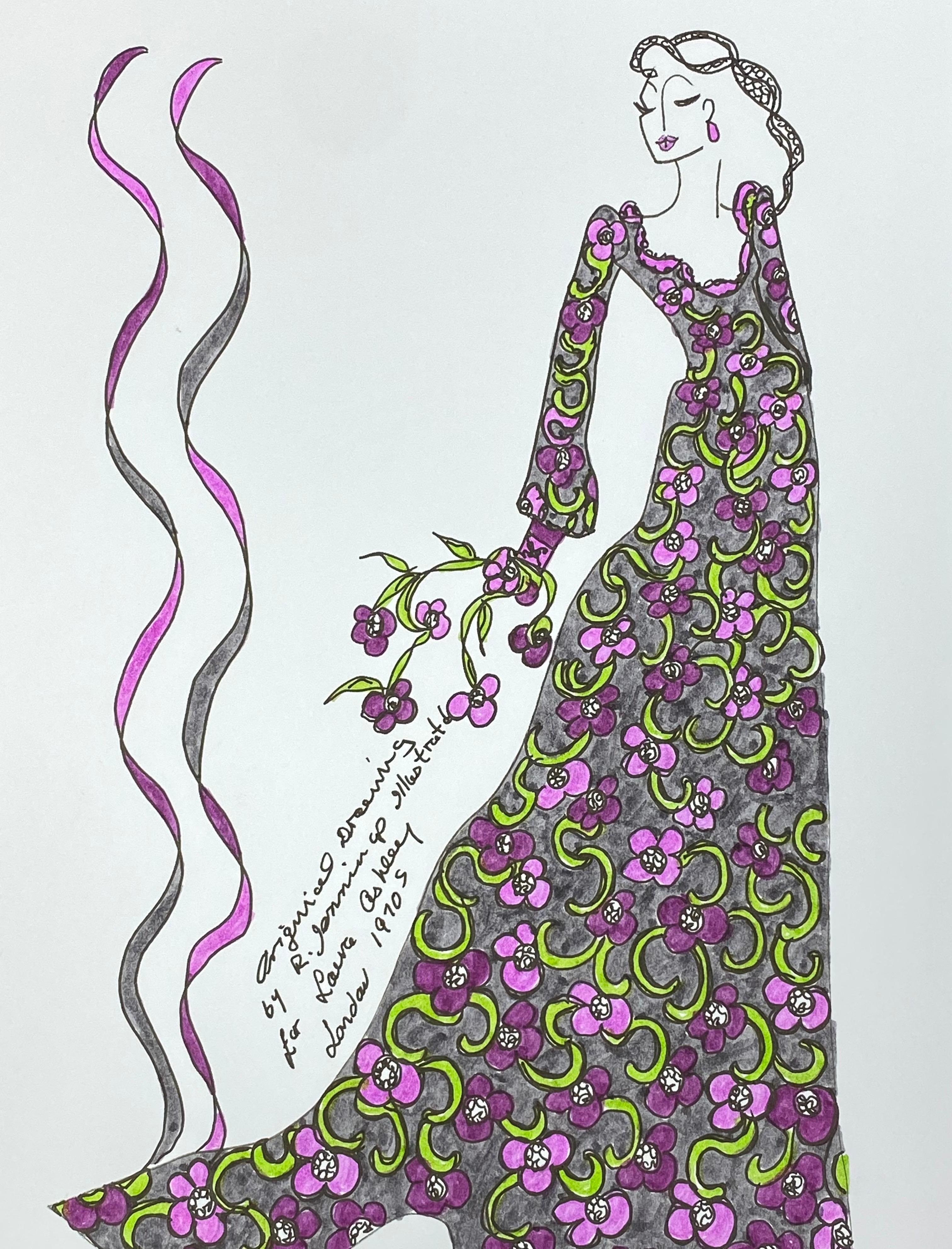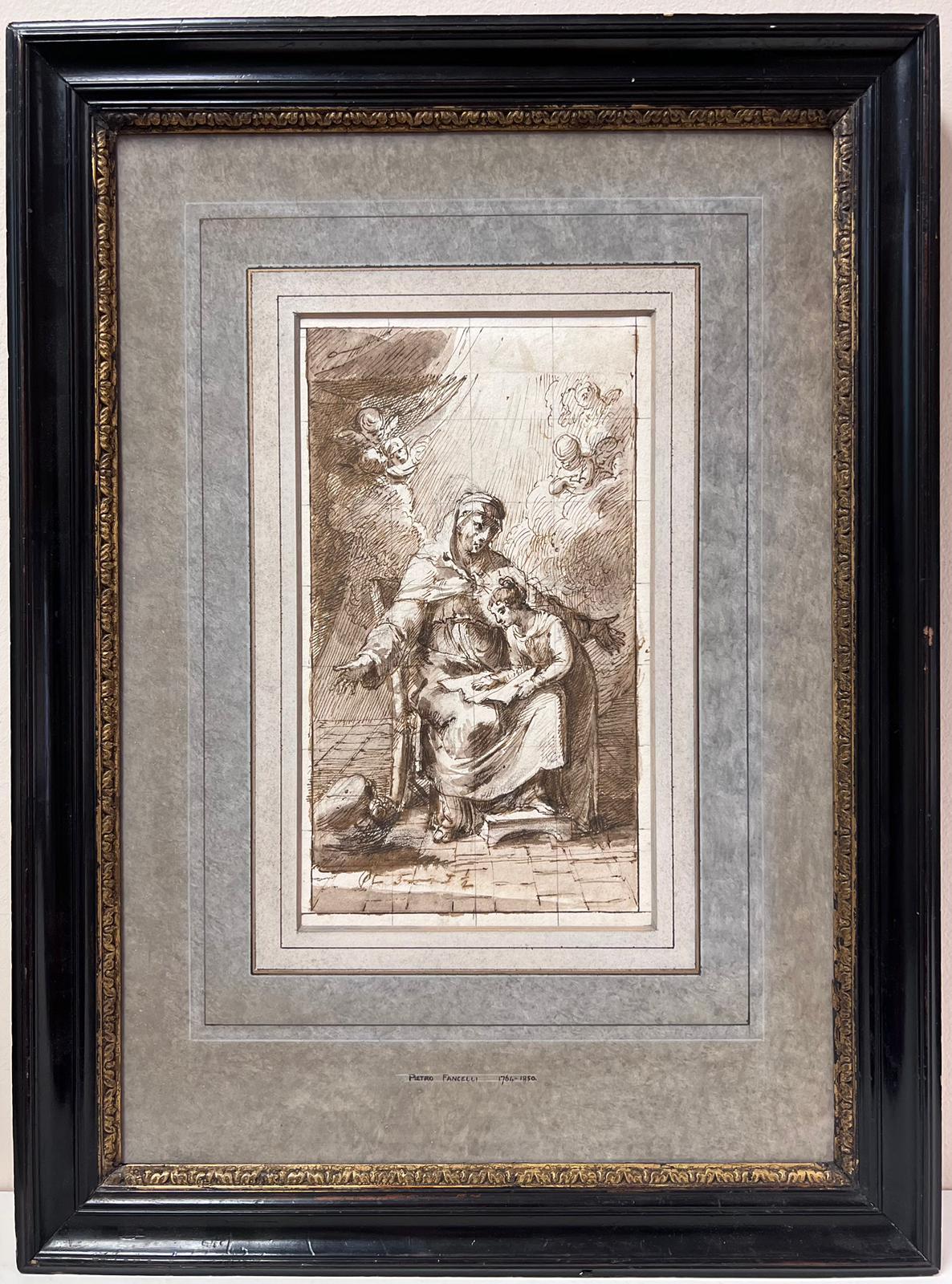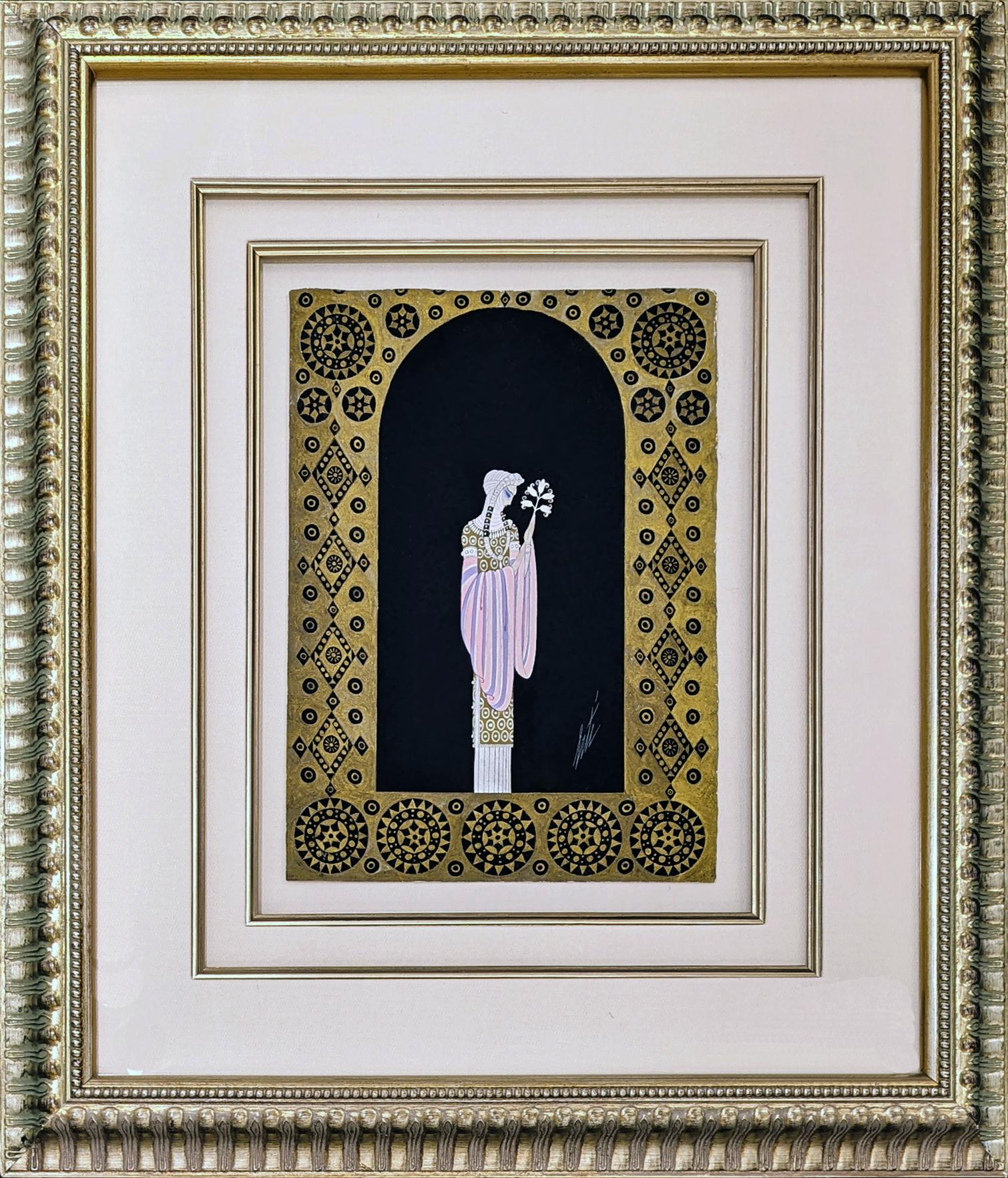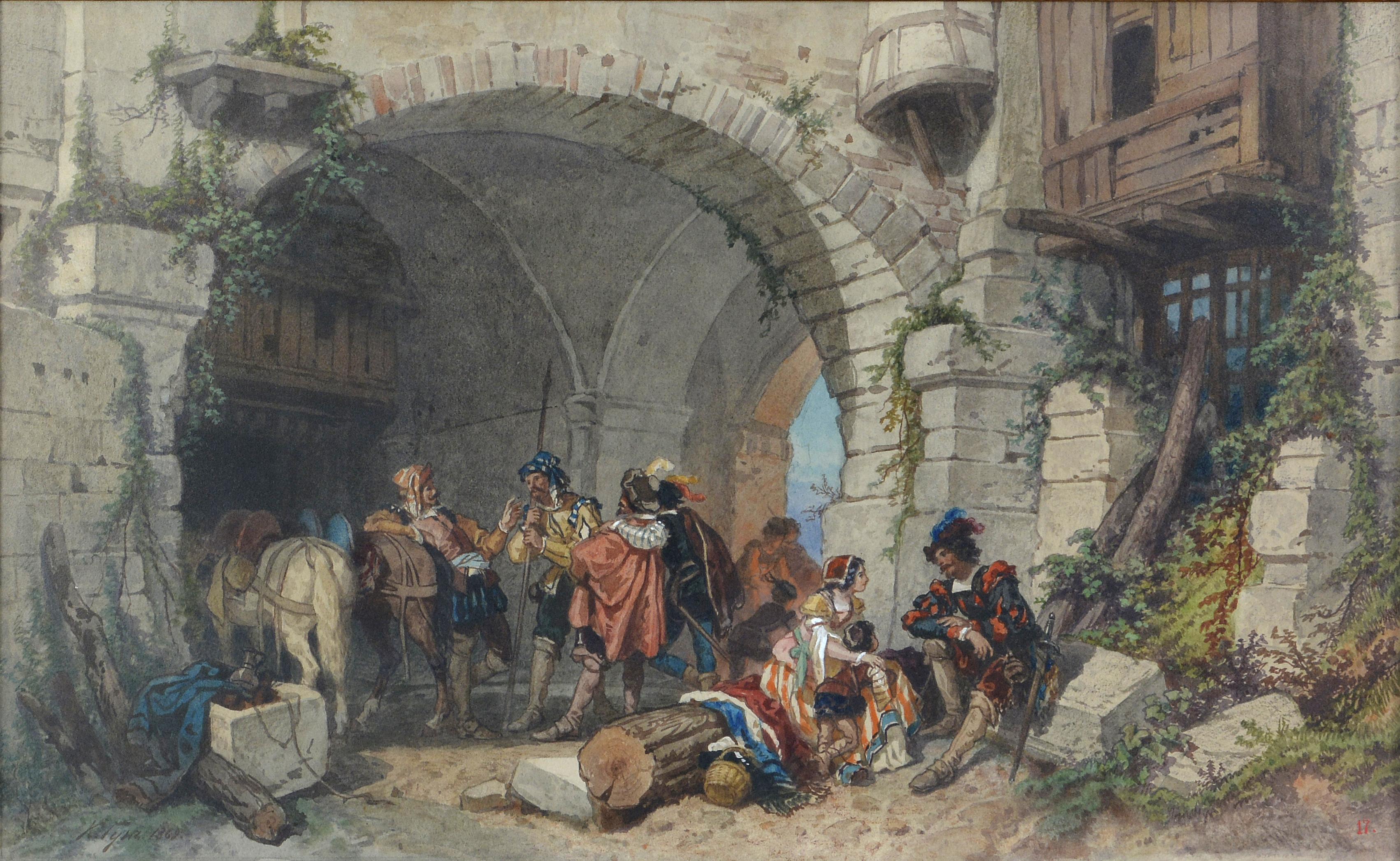Items Similar to Fine 1900’s English Watercolour Painting Lady by Cottage Steps Signed
Want more images or videos?
Request additional images or videos from the seller
1 of 11
Gunn GwennetFine 1900’s English Watercolour Painting Lady by Cottage Steps Signed1900’s
1900’s
About the Item
The Cottage Steps
By Gunn Gwennet (British early 1900’s)
signed watercolor painting on paper mounted in a frame.
framed: 21 x 18 inches
Image: 14 x 9.75 inches
provenance: private collection, England
condition: overall very good
- Creator:Gunn Gwennet
- Creation Year:1900’s
- Dimensions:Height: 21 in (53.34 cm)Width: 18 in (45.72 cm)
- Medium:
- Period:
- Condition:
- Gallery Location:Cirencester, GB
- Reference Number:1stDibs: LU509311891312

About the Seller
5.0
Platinum Seller
These expertly vetted sellers are 1stDibs' most experienced sellers and are rated highest by our customers.
Established in 1989
1stDibs seller since 2016
3,474 sales on 1stDibs
Typical response time: 2 hours
- ShippingRetrieving quote...Ships From: Cirencester, United Kingdom
- Return PolicyA return for this item may be initiated within 3 days of delivery.
More From This SellerView All
- Original Fashion Design Illustration Watercolor Painting Laura Ashley DesignerBy Roz JenningsLocated in Cirencester, GloucestershireOriginal Fashion Design Illustration by Roz Jennings, British watercolor and ink on card, unframed size: 12 x 8.25 inches condition: very good A beautifully colorful and characterfu...Category
Late 20th Century Pop Art Figurative Paintings
MaterialsWatercolor, Ink
- Italian Old Master Ink & Wash Drawing St. Anne & The Virgin Mary with CherubsLocated in Cirencester, GloucestershirePietro Fancelli (Italian 1764 - 1850) bio details attached to the frame 'St. Anne & The Virgin' ink with watercolor wash on paper, framed framed: 22 x 16 inches image: 11 x 6.5 inche...Category
Late 18th Century Old Masters Figurative Drawings and Watercolors
MaterialsWatercolor, Ink
- 1950's Modernist/ Cubist Painting - Blue Watercolor Knight and Horse StatueBy Bernard LabbeLocated in Cirencester, GloucestershireFrench Landscape by Bernard Labbe (French mid 20th century) original gouache on paper size: 13.75 x 10.5 inches condition: very good and ready to be enjoyed provenance: the artists ...Category
Mid-20th Century Modern Figurative Paintings
MaterialsGouache
- 1960's French Modernist Cubist Painting Gentleman In Red With ViolinLocated in Cirencester, Gloucestershireby Paul-Louis Bolot (French 1918-2003) signed & dated 1968 original gouache painting on thick paper/ card unframed condition: very good and sound; the edges have a few curls and scuf...Category
20th Century Cubist Figurative Paintings
MaterialsGouache
- Fine 1700's Italian Old Master Ink & Wash Drawing Roman Allegorical NapoliLocated in Cirencester, Gloucestershire'Napoli' Italian School, 18th century ink and wash drawing on paper, framed within a light oak wood frame (behind glass) image size: 10.5 x 7 inches overall framed: 17 x 13 inches co...Category
18th Century Old Masters Figurative Paintings
MaterialsWatercolor, Ink, Archival Paper
- 1950's Modernist/ Cubist Painting - Two Hunts MenBy Bernard LabbeLocated in Cirencester, GloucestershireFrench Figures by Bernard Labbe (French mid 20th century) original gouache on card, mounted on card size: 19.5 x 13.5 inches condition: very good and re...Category
Mid-20th Century Modern Figurative Paintings
MaterialsGouache
You May Also Like
- The Abduction of the Sabine Women , a Renaissance drawing by Biagio PupiniLocated in PARIS, FRThis vigorous drawing has long been attributed to Polidoro da Caravaggio: The Abduction of the Sabine Women is one of the scenes that Polidoro depicted between 1525 and 1527 on the façade of the Milesi Palazzo in Rome. However, the proximity to another drawing inspired by this same façade, kept at the Ecole des Beaux-Arts, and to other drawings inspired by Polidoro kept at the Musée du Louvre, leads us to propose an attribution to Biagio Pupini, a Bolognese artist whose life remains barely known, despite the abundant number of drawings attributed to him. 1. Biagio Pupini, a Bolognese artist in the light of the Roman Renaissance The early life of Biagio Pupini, an important figure of the first half of the Cinquecento in Bologna - Vasari mentions him several times - is still poorly known. Neither his date of birth (probably around 1490-1495) nor his training are known. He is said to have been a pupil of Francesco Francia (1450 - 1517) and his name appears for the first time in 1511 in a contract with the painter Bagnacavallo (c. 1484 - 1542) for the frescoes of a church in Faenza. He then collaborated with Girolamo da Carpi, at San Michele in Bosco and at the villa of Belriguardo. He must have gone to Rome for the first time with Bagnacavallo between 1511 and 1519. There he discovered the art of Raphael, with whom he might have worked, and that of Polidoro da Caravaggio. This first visit, and those that followed, were the occasion for an intense study of ancient and modern art, as illustrated by his abundant graphic production. Polidoro da Caravaggio had a particular influence on the technique adopted by Pupini. Executed on coloured paper, his drawings generally combine pen, brown ink and wash with abundant highlights of white gouache, as in the drawing presented here. 2. The Abduction of the Sabine Women Our drawing is an adaptation of a fresco painted between 1525 and 1527 by Polidoro da Caravaggio on the façade of the Milesi Palace in Rome. These painted façades were very famous from the moment they were painted and inspired many artists during their stay in Rome. These frescoes are now very deteriorated and difficult to see, as the palace is in a rather narrow street. The episode of the abduction of the Sabine women (which appears in the centre of the photo above) is a historical theme that goes back to the origins of Rome and is recounted both by Titus Livius (Ab Urbe condita I,13), by Ovid (Fasti III, 199-228) and by Plutarch (II, Romulus 14-19). After killing his twin brother Romus, Romulus populates the city of Rome by opening it up to refugees and brigands and finds himself with an excess of men. Because of their reputation, none of the inhabitants of the neighbouring cities want to give them their daughters in marriage. The Romans then decide to invite their Sabine neighbours to a great feast during which they slaughter the Sabines and kidnap their daughters. The engraving made by Giovanni Battista Gallestruzzi (1618 - 1677) around 1656-1658 gives us a good understanding of the Polidoro fresco, allowing us to see how Biagio Pupini reworked the scene to extract this dynamic group. With a remarkable economy of means, Biagio Pupini takes over the left-hand side of the fresco and depicts in a very dense space two main groups, each consisting of a Roman and a Sabine, completed by a group of three soldiers in the background (which seems to differ quite significantly from Polidoro's composition). The balance of the drawing is based on a very strongly structured composition. The drawing is organised around a median vertical axis, which runs along both the elbow of the kidnapped Sabine on the left and the foot of her captor, and the two main diagonals, reinforced by four secondary diagonals. This diamond-shaped structure creates an extremely dynamic space, in which centripetal movements (the legs of the Sabine on the right, the arm of the soldier on the back at the top right) and centrifugal movements (the arm of the kidnapper on the left and the legs of the Sabine he is carrying away, the arm of the Sabine on the right) oppose each other, giving the drawing the appearance of a whirlpool around a central point of support situated slightly to the left of the navel of the kidnapper on the right. 3. Polidoro da Caravaggio, and the decorations of Roman palaces Polidoro da Caravaggio was a paradoxical artist who entered Raphael's (1483 - 1520) workshop at a very young age, when he oversaw the Lodges in the Vatican. Most of his Roman work, which was the peak of his career, has disappeared, as he specialised in facade painting, and yet these paintings, which are eminently visible in urban spaces, have influenced generations of artists who copied them abundantly during their visits to Rome. Polidoro Caldara was born in Caravaggio around 1495-1500 (the birthplace of Michelangelo Merisi, known as Caravaggio, who was born there in 1571), some forty kilometres east of Milan. According to Vasari, he arrived as a mason on the Vatican's construction site and joined Raphael's workshop around 1517 (at the age of eighteen according to Vasari). This integration would have allowed Polidoro to work not only on the frescoes of the Lodges, but also on some of the frescoes of the Chambers, as well as on the flat of Cardinal Bibiena in the Vatican. After Raphael's death in 1520, Polidoro worked first with Perin del Vaga before joining forces with Maturino of Florence (1490 - 1528), whom he had also known in Raphael's workshop. Together they specialised in the painting of palace façades. They were to produce some forty façades decorated with grisaille paintings imitating antique bas-reliefs. The Sack of Rome in 1527, during which his friend Maturino was killed, led Polidoro to flee first to Naples (where he had already stayed in 1523), then to Messina. It was while he was preparing his return to the peninsula that he was murdered by one of his assistants, Tonno Calabrese, in 1543. In his Vite, Vasari celebrated Polidoro as the greatest façade decorator of his time, noting that "there is no flat, palace, garden or villa in Rome that does not contain a work by Polidoro". Polidoro's facade decorations, most of which have disappeared as they were displayed in the open air, constitute the most important lost chapter of Roman art of the Cinquecento. The few surviving drawings of the painter can, however, give an idea of the original appearance of his murals and show that he was an artist of remarkable and highly original genius. 4. The façade of the Milesi Palace Giovanni Antonio Milesi, who commissioned this palace, located not far from the Tiber, north of Piazza Navona, was a native of the Bergamo area, like Polidoro, with whom he maintained close friendly ties. Executed in the last years before the Sack of Rome, around 1526-1527, the decoration of Palazzo Milesi is considered Polidoro's greatest decorative success. An engraving by Ernesto Maccari made at the end of the nineteenth century allows us to understand the general balance of this façade, which was still well preserved at the time. The frescoes were not entirely monochrome, but alternated elements in chiaroscuro simulating marble bas-reliefs and those in ochre simulating bronze and gold vases...Category
16th Century Old Masters Figurative Drawings and Watercolors
MaterialsInk, Gouache, Pen
- LA PRINCESSE LOINTAINE: LES FEMMES DE MILISSINDEBy ErtéLocated in Aventura, FLOriginal on Gouache on paper. Hand signed on front; signed, titled, dated with dedication on verso. Stamped "Composition originale". Frame size 30.5 x 26.5 inches. Artwork is in e...Category
1920s Art Deco Figurative Paintings
MaterialsGouache
- In the yard. 1869, watercolor on paper, 30, 5 x 47, 5 cmLocated in Riga, LVIn the yard. 1869, watercolor on paper, 30, 5 x 47, 5 cm C. J. W. Huns was born in the family of Estonian teacher, organ player and sacristan Karl Fridrich Huhn. He studied in Rig...Category
1860s Realist Figurative Drawings and Watercolors
MaterialsWatercolor, Paper
- Richard Caton Woodville II (1856 - 1927) 1794 War Balloon Aquarell England 1910By Richard Caton Woodville Jr.Located in Meinisberg, CHRichard Caton Woodville II (British, 1856 - 1927) The French Aerostatic Corps - The first War Balloon The launching of the L'Entreprenant used by the French Army under General Jourd...Category
1910s English School Figurative Drawings and Watercolors
MaterialsPaper, Watercolor, Gouache, Cardboard
- Original Graphic Hungarian Illustration Art Emma Heinzelmann Children's Book ArtLocated in Surfside, FLOriginal vintage gouache painting on poster board by Emma Heinzelmann (Hungarian, born 1930). Hungarian Peasant art, children fairytale themes, in psychedelic pop colors of the era. This framed painting depicts figures, a rooster and angels in flying above. Artist signature on farm gate. Housed in chrome mid century frame. Framed: 19.5 X 25.5 image is 15 X 21. Emma Heinzelmann ( Nyírbátor , March 14 , 1930 - ) Munkácsy Prize-winning Hungarian graphic designer and illustrator. Heinzelmann is a Hungarian children's book illustrator and graphic poster artist, who started her career during the 1950’s. She has a very unique drawing style that resembles children’s book illustrations. Working in psychedelic pop colors of the era. She Initially she studied to be a costume designer but she soon turned to graphic design. She graduated in 1950 from the clothing design department at the Junior High School in Török Pál Street which operated under the name Szépmíves Lyceum from 1946 to 1950. His master was György Farkas, a ceramicist, painter and sculptor. She creates her compositions using mainly watercolor and gouache paint. She often worked on illustrations for children’s books, since her style fits their themes. Her posters show the same playful Hungarian Folk Art style. She has produced artwork in almost all areas of applied graphics. posters, commemorative cards, designed album covers, postcards, advertising graphics, slide films, animation and cartoons. Her drawings were published in Dörmögő Dömötör and Kisdobos among others as well as in children's magazines. An entire generation of children grew up with her book illustrations, reading the fairy tales of Wilhelm Hauff or Hans Christian Andersen. Her story books and drawings are known well beyond our borders. She illustrated nearly 80 storybooks. She is a contemporary of Maurice Sendak and William Steig. Her work is of the same genre as the iconic Polish Cyrk poster artists. In her original fine art graphics grotesque and bitter elements often prevail, her figures are playfully ironic. Her drawings are made in a variety of ways, from pencil drawings to watercolor painting to collage techniques, from decorative spot effects to lace-like line drawings. She is no stranger to a kind of Art Nouveau influence, but it is always individual. It was never beautiful, but over the years its color scheme changed, thus confirming the lines of József Somogyi quoted earlier. She had several individual exhibitions, and for more than 10 years as a member of the Papp-Gábor group, her works could be seen in Dorottya Street. In 2009 , the book of art historian András Székely was published by Holnap Könyvkiadó under the title Emma Heinzelmann: fairy tales in the drawing. Awards and recognitions Lot Prize (International Poster Biennale, Warsaw) (1972) Ministry of Culture Award (1977, 1979) Brno Graphic Biennale (Bronze Award) (1980) Worker's Award (1984) Children's Book of the Year Award (1984) IBBY Andersen Diploma (1988) Hamburg Lifetime Achievement Award (1990) Albert Star Award (1992) Noémi Ferenczy Award (2005) Munkácsy Award (1984) Solo Exhibitions: Thought Bookstore, Budapest (1965) Cultural Center, Nyíregyháza (1974) Little Gallery, Komárom (1982) Art Gallery, Budapest. (1990) Vác (2010) Selected group exhibitions: International Children's Book Fair and Exhibition, Bologna (1971-1975) International Graphic Biennale, Brno (1966-1985) BIB (Children's book illustration biennial), Bratislava (1970-1985) XXXVI. Venice Biennale, Venice (1972) ARC. International Poster Biennale, Warsaw (1972) International Poster Triennale (B) (1972-1974) Weekdays, graphic exhibition, (1975) Calligraphy and typography, Institute of Cultural Relations, Budapest (1977) "Falrahányt pea", graphic exhibition, Institute of Cultural Relations, Budapest.(1978) International Poster Triennale (B) (1978) National Poster Exhibitions, Art Gallery, Budapest (1978)(1980) International Poster Exhibition (IR) (1979) Slide films: Fairy tales with Emma Heinzelmann's drawings: Under the Shore (1981) Goose Party (1981) Take a Little Trumpet (1982) The Bremen Town...Category
Mid-20th Century Folk Art Figurative Paintings
MaterialsGouache
- "Children" Little girl, child, red, blue, reading cm. 31 x 24 1980By Olga BOGAEVSKAJALocated in Torino, ITLittle girl, child, red, blue, reading we send the work anywhere Shipping included OLGA BOGAEVSKAJA (Moscow, 1916 – St. Petersburg, 2000) Works by Olga Bogaevskaja can be found in v...Category
1980s Impressionist Figurative Drawings and Watercolors
MaterialsWatercolor





